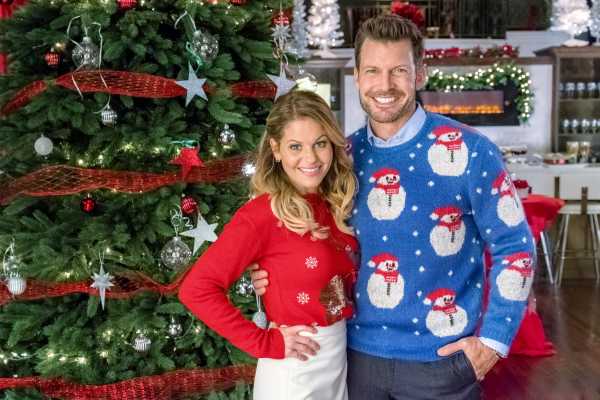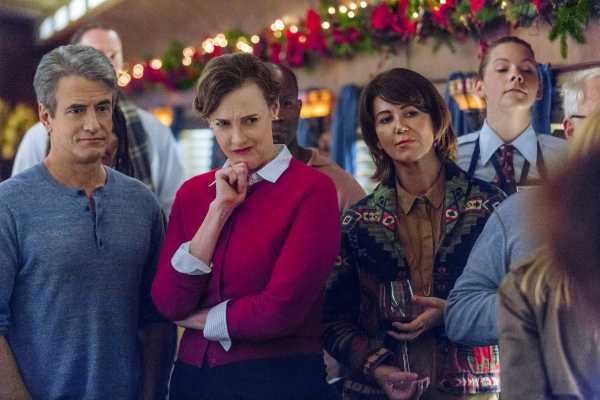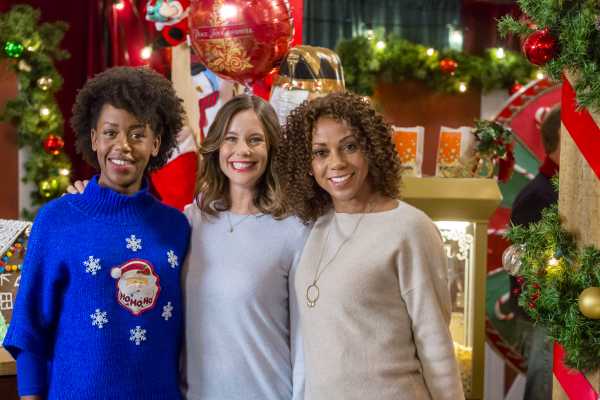
There is a place where it’s always Christmas. Where there is always snow on the ground, where togetherness is the word to live by, where the horrors of the world reliably subside amid the flurries of a beautiful snowstorm. If, in Narnia, it was always winter but never Christmas, then on the Hallmark Channel, it’s always winter and always Christmas (at least between the months of October and January).
The standard line about Hallmark’s endless parade of made-for-TV Christmas movies is that they’re dumb and super cheesy, but they give your grandmother something to watch. They embrace ideas of tradition and family, but only in the vaguest sense. They’re apolitical in a way that people who blanch at the idea that all art is political call apolitical.
I should admit up front that I love a good Hallmark Christmas movie. I’ll watch just about any Hallmark Christmas movie I stumble upon, but my favorite, 2014’s Nine Lives of Christmas, involves a fireman played by Brandon Routh who finds love at Christmas because he adopts a cat who befriends another cat, and the other cat just so happens to belong to the woman our hero is meant to be with.
Christmas and cats represent a pretty perfect Venn diagram intersection of my interests, to be sure, but Nine Lives also underlines why the best Hallmark Christmas movies work. They are always, unabashedly themselves, unashamed of coming off as square, corny, old-fashioned. Nobody so much as swears, and true love is always just around the corner, even for those who may seem like lost causes.
“People love their Christmas movies!” Hallmark mainstay Kellie Martin (who’s only starred in one of the channel’s Christmas movies) told me during a podcast we recorded in 2017. “They’re like candy. They’re delightful.”
Martin’s right. Hallmark Christmas movies feel nostalgic for something half-understood, like those episodes of The Twilight Zone where somebody travels back to the 1890s or the 1910s in hopes of chasing some America that has been lost to the mists of time. Except, where the Twilight Zone traveler eventually realizes the error of his or her ways, a Hallmark protagonist comes to love living in the bubble — or the snow globe, if you will. And when these movies are done well, their most fervent fans are right there, ready to embrace that snow globe themselves.
Of course, Hallmark movies are also a major, major economic engine for a cable channel you probably don’t think about that often — albeit one with an intriguing, unique way of thinking about programming the TV year that has paid it back many times over.
Hallmark’s two networks made 37 original Christmas movies in 2018 — and more than 80 million people will watch them

The obvious answer to why Christmas completely dominates Hallmark’s winter programming lineup (and that of its sister channel, Hallmark Movies & Mysteries) is that it makes the channel money. Lots and lots of money.
While Hallmark routinely places in the top 20 and even the top 10 among cable channels in its key demographics (women 25 to 54 and women 18 to 49) during the rest of the year, it immediately vaulted into first place in November, a position it should maintain throughout December. The opening weekend of the channel’s annual Christmaspalooza drew 15.2 million unique viewers in 2016, but in 2017, it pulled in 17.6 million unique viewers, a 16 percent increase.
Those numbers have only continued to rise in 2018, which has seen 69.2 million unique viewers across the various Hallmark channels (Hallmark, Hallmark Movies & Mysteries, and Hallmark Drama, which all fall under the umbrella of Crown Media Family Networks) through Sunday, December 16. At that trajectory, the company just might crack 90 million viewers by the time its Christmas extravaganza ends in early January. And it shouldn’t have any trouble topping last year’s total of just over 85 million viewers.
I could overwhelm you with data about how Christmas buoys both Hallmark and Hallmark Movies & Mysteries (which posts more modest ratings in general but also sees solid increases throughout the holiday season), but if you really want to dig into the raw numbers, AdWeek has them here. Suffice to say that the Christmas season is so massive for Hallmark’s TV properties that it even buoys the company’s streaming site, Hallmark Movies NOW, which grew 49 percent between October and December 2017.
What’s more, this whole operation is hugely profitable. While it invests more heavily in some movies than others, it’s not like it has to pay for extensive special effects sequences or stunts in any of them. The casts typically feature actors you recognize, but also actors who haven’t done much non-Hallmark work in recent years. And the channel primarily works with independent production companies that know how to make films like these quickly, usually over two or three weeks. Product placement also occasionally enters the equation. 2017’s Switched for Christmas, for instance, was sponsored by Christmas emporium Balsam Hill.
And most (if not all) these movies will run for year after year — the 2006 entry The Christmas Card, which first helped Hallmark realize it could go all-in on Christmas in November and December, has continued to air every holiday season since its debut. Even if the network didn’t turn a profit on it in 2006, the film has since paid for itself many times over, thanks to its enduring popularity. That sort of long-tail success allows the channels to keep making new Christmas movies, including 37 new ones premiering on Hallmark channels in 2018 alone.
And with its streaming service Hallmark Movies NOW, Hallmark has essentially created an endless media ecosystem just for itself. First you watch a Hallmark movie on TV (and take in all of the ads that fund the movie’s production budget). Then, if you want to watch it again right away, you can subscribe to NOW, and all of that money flows back into the Crown Media coffers.
Meanwhile, Christmas has also become an unlikely year-round programming strategy for Hallmark. Even though its channels don’t air Christmas movies 365 days in a row, its Christmastime strategy is gradually colonizing the rest of its calendar, from its Winterfest in January to its countdown to Valentine’s Day in February to its Harvest Festival month in the fall.
“[Christmas] serves as a great promotional platform to tee all of [our programming] up for the following year. It falls at the perfect time for really looking at our strategy around our franchises and laying out the calendar, almost like a retail company would,” says Bill Abbott, the network’s CEO.
Few TV networks program to the change of the seasons like Hallmark does, and it’s part of the network’s contradictory appeal. Turn it on, and you’ll find something that feels vaguely timeless (in that it probably could have been made in the 1940s) but also applicable to whatever time of year it is right now.
“The season changing is such an important time for people,” Michelle Vicary, the executive vice president of programming and publicity for Crown Media, told me in 2017. “We celebrate the entire year with people.” But, she laughs, “That’s not to say that in the halls we haven’t said, ‘Wouldn’t it be great if we did Christmas all year long?’”
How a Hallmark Christmas movie is made

When I brought up Nine Lives of Christmas to Vicary and mentioned, offhand, that the movie’s climactic Christmas events take place in a town full of green grass and leafy trees, she immediately asked Hallmark’s PR rep when the movie was made. After learning it was shot in 2014, she began to explain just how extensively Hallmark has upped its efforts in recent years to make sure all of its movies look like Christmas, even if they’re filmed in July. (Yep, Hallmark Christmas movies are produced year-round. Martin told me she filmed hers during the summer: “You wear hats and scarves, and you’re sweating all the time.”)
“We have continued every year to make an even deeper, concerted effort to make sure that everything looks Christmas,” Vicary told me, to replace the summer sun with fake winter chill. “[We want to make sure] the decorations are really of the season and everything looks snowy and beautiful.”
And to achieve that atmosphere, as an anonymous writer of Hallmark Christmas movies explained in an interview with Entertainment Weekly:
As you can see, snow is of paramount importance to the Hallmark Christmas movie machine. Right now, as you read this story, the Hallmark development team is deciding which of its Christmas movie scripts for 2019 are its highest priorities, so they might film in January and February and have the benefit of real snow. (Most Hallmark movies are filmed in the Vancouver area; you can read more about the perils of finding believable small towns that haven’t been overused for Hallmark productions in the Wall Street Journal.) Other factors, like the availability of certain actors or directors, might take precedence, but the snow — the snow’s a big deal.
The effort to find real snow also underlines something key about Hallmark’s Christmas movies: Some of them are a lot more “high-touch” than others. The network’s foremost debut of 2017, The Christmas Train — which bowed on Hallmark and Hallmark Movies & Mysteries on the same night, drawing 6 million viewers — was dubbed a “Hallmark Hall of Fame” presentation. The movie’s cast boasts Danny Glover and Joan Cusack, and it’s based on a popular David Baldacci novel; it is, as these things go, a prestige picture.
Indeed, the Hall of Fame label also explains the existence of the Hallmark channel in the first place. Since December 24, 1951, programs classified as part of the “Hallmark Hall of Fame” have aired occasionally, across several different (non-Hallmark) networks, including NBC, CBS, and ABC — before decamping entirely for Hallmark Channel in 2014. They’re also the reason the Hallmark greeting card company (which owns Crown Media Networks) has a major TV presence at all, much less cable networks.
Originally designated as such because the greeting card company sponsored the programs, Hallmark Hall of Fame movies and specials now comprise the only remaining programming on US television to continue the once-common practice of a project bearing its sponsor’s name in the title.
Hall of Fame has been wildly successful, winning 80 Emmys, among other awards, throughout its 67-year run. It began as a series that showcased Shakespeare and opera and other high-culture programming, but has gradually come to mean “family-friendly yet well-made,” and often enjoys bigger budgets than most made-for-TV movies (a practice that continues now that it airs exclusively on the Hallmark Channel).
But real snow on the ground and the “Hall of Fame” imprimatur aren’t the only ways to tell which Hallmark Christmas movies are considered the network’s top priorities. Certain performers have big enough fan bases among the Hallmark audience that their projects are essentially granted top billing by default. Candace Cameron Bure (originally of Full House fame) has made a Christmas movie for Hallmark every year since 2013. She’s time-traveled. She’s switched places with an identical twin (also played by Candace Cameron Bure, of course). She’s moved to a remote Alaskan town. And Hallmark viewers have watched all of them.
(Not to be outdone, Party of Five and Mean Girls alum Lacey Chabert has starred in a Hallmark Christmas movie in every year except 2013 since 2012, including entries where she’s married a prince and traveled to a parallel universe.)
But when you’re producing 37 Christmas movies in a single year, some of them are going to miss the mark a bit. A great Hallmark Christmas movie feels like beautiful grandparent wish fulfillment, complete with gorgeous snow falling from the sky and just the right amount of cheese. It’s not Citizen Kane — or even, like, How to Lose a Guy in 10 Days — but it has a spirit all its own. A less successful Hallmark Christmas movie can feel indifferent, churned out by a factory that’s simply assembling enough product to fill the schedule.
And yet even the less successful movies can end up building Hallmark’s brand in a weird way. Abbott points to how the channel’s Christmas movies can be spoofed in the sorts of places that rarely talk about Hallmark’s programming in other contexts. There are Twitter jokes and YouTube gags and podcasts. It can feel like Hallmark Christmas movies are everywhere.
“I don’t think any of us, when we decided to do it, realized how we had really hit on something that was going to be as big as it’s turned out to be,” says Abbott, who’s worked for Hallmark for 18 years and been the network’s CEO for 10.
What’s surprising, however, is just how often Hallmark Christmas movies hit their very specific mark. Vicary attributes the films’ success rate to Hallmark’s relentless focus on CHRISTMAS, in all caps. “There’s a wide range of things that happen to people over the holiday season, and we try to represent those,” she told me. “What we won’t do is we won’t just make Christmas a backdrop. It has to be infused. The spirit of the season has to be represented in the movie.”
Hallmark Christmas movies always maintain a traditionalist, conservative streak, one the channel is loathe to stray from

What we know today as the Hallmark Channel began life as two different religious programmers sharing space on the same satellite transponder. The two eventually merged, in 1993, to form the Faith and Values Channel, which was later renamed the Odyssey Network. The Hallmark greeting card company, with an assist from the Jim Henson Company (yes, really!), bought Odyssey in 1998, eventually relaunching it in 2001 as the Hallmark Channel.
Hallmark doesn’t air religious programming, but its roots as a religious network, combined with its family-friendly standard, have yielded an M.O. that is very, very traditionalist.
“It does bother me sometimes when they’re, like, ‘Oh, you can’t wear that shirt, because it shows too much cleavage,’” Martin told me, in the midst of praising Hallmark for its ability to produce enjoyable family-friendly programming. “But they know their audience, and they are fiercely loyal to their audience, which is why they use all the same actors. Their audience likes those people.”
Hallmark specializes in movies about single women who find love at Christmas, or families who reunite at Christmas, or families of single women who reunite and find love at Christmas. The characters in these movies tend to be white, and a lot of the movies conclude with a career woman giving up her life’s work for love. If you’re of a progressive political bent, it’s easy to feel vaguely discomfited by all of it.
When I asked Vicary about the network’s diversity record, in particular, her answer wasn’t especially encouraging. She pointed out that two of the network’s 2017 Christmas offerings, Christmas at Holly Lodge and Christmas in Evergreen, featured black performers in prominent roles (and she might have also mentioned Danny Glover’s turn in 2017’s The Christmas Train), but these movies are still all led by white characters. The black characters have more to do than they might have in past Hallmark Christmas movies, but they still amount to super supportive pals, mostly.
That’s not to say that Hallmark isn’t trying. Its 2018 Christmas offerings did a better job of diversifying their supporting casts than the network ever had before, to say nothing of Christmas Everlasting, which boasted a cast of mostly black actors. But even being charitable to the network, it’s natural to wonder if it hasn’t realized that wholesome family entertainment dripping with cheese can be enjoyed by non-white audiences as well.
And yet Hallmark Christmas movies aren’t overtly agenda-driven in the way that, say, Fox News is. They might skew toward social conservatism, but the network isn’t telling these stories in hopes of making Christmas great again, at least not in a way where the movies preach such a message to your face.
With that said, nobody in a Hallmark Christmas movie would ever greet someone with “Happy holidays,” either. The channel is telling these stories because there’s an audience and because that audience isn’t particularly well-served elsewhere. If you just want to watch a nice story about Christmas, with absolutely no outwardly objectionable elements and a heartwarming ending, well, Hallmark Christmas movies are kind of your only option.
“Entertainment tells stories about the human condition and where people are at in their lives. A lot of our competitors focus on the darker and the edgier and the topical and the fractured place that many people find themselves in,” Vicary told me. “What we do so well is illustrate the other side of the human condition, which is coming together. We really don’t feel that what people come to Hallmark for is to get another instance of the difficult times.”
And, really, in a way, isn’t that what Christmas is all about? It’s commercialism and capitalism blowing the trumpets to herald the arrival of one day a year when it’s completely acceptable to yearn for a hazy, barely remembered past full of sleigh rides and ice-skating and family togetherness. We gather our loved ones close to us, sometimes to yell and shout and air our grievances, but also, maybe, to find a way to be slightly kinder to one another. And those moments of kindness, few and fleeting, are worth remembering — even if they’re buried underneath an avalanche of fake snow melting in the Vancouver sun.
Sourse: vox.com






